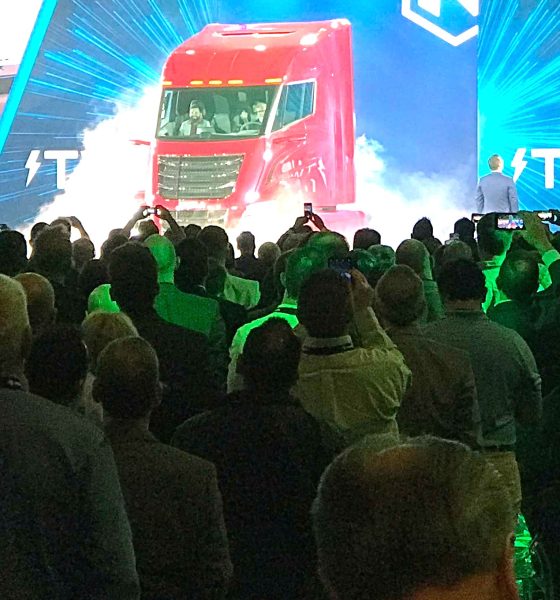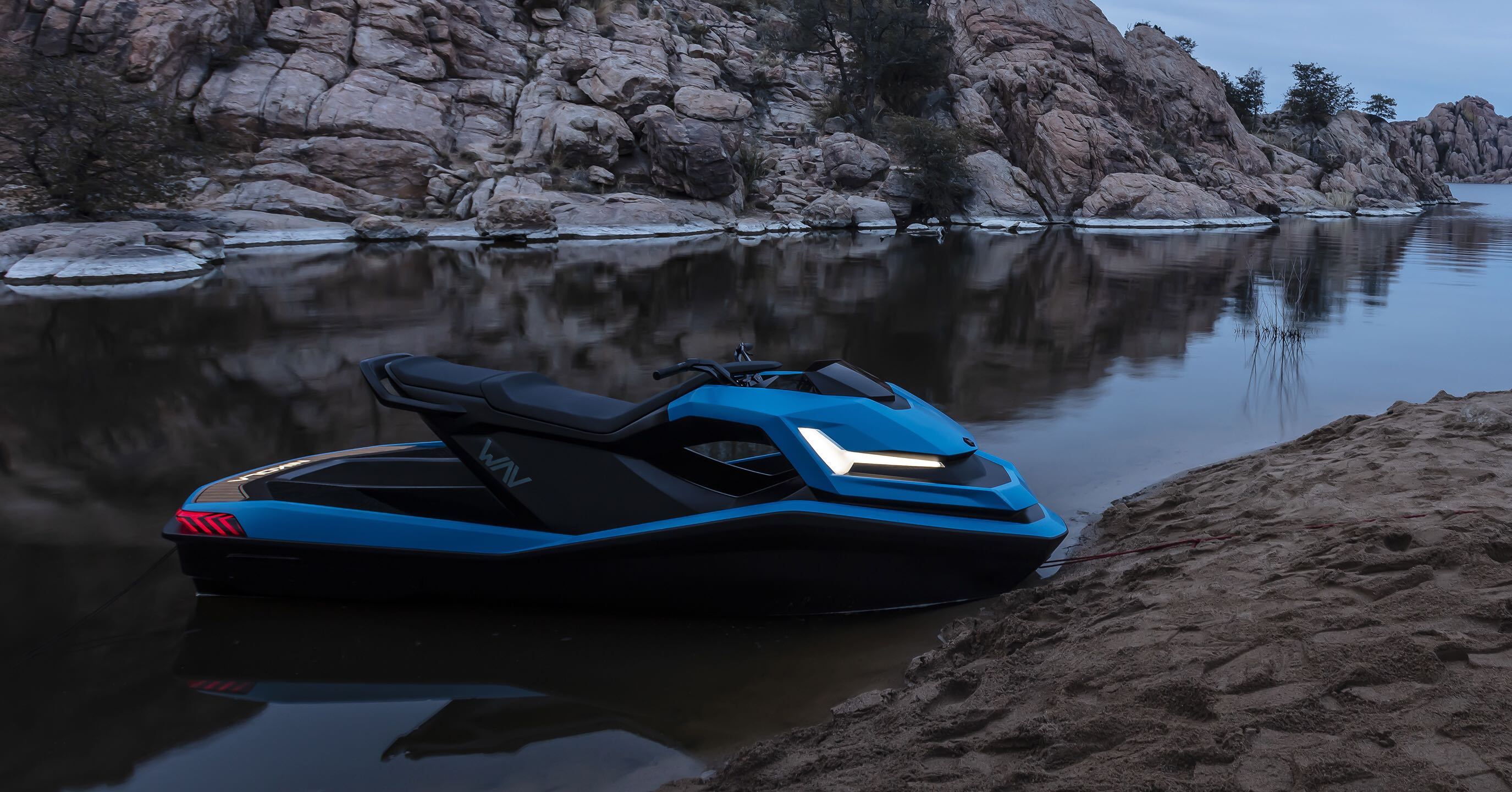

News
Nikola unveils five new zero-emissions vehicles at Nikola World 2019 event
Nikola Motors unveiled its Nikola Two and Nikola Tre hydrogen-electric semi trucks along with three other new emissions-free transportation products at its Nikola World 2019 event. The company’s core mission is to rid the transportation industry of its reliance on diesel fuel, and their primary path to that future is via advanced hydrogen fuel cell technology.
Trevor Milton, CEO and founder of Nikola, kicked off the event by arriving onstage with the iconic Budweiser Clydesdales. Annheuser-Busch has ordered 800 trucks from Nikola as part of the iconic beer brewing company’s sustainability mission. “I cannot wait to see your truck pull a load of Budweiser,” Ingrid De Ryck, VP of Procurement and Sustainability for Annheuser exclaimed later in the evening’s presentation.
I cannot wait to see @nikolamotor trucks hauling @budweiserusa beers – Budweiser at #NikolaWorld2019 – they've ordered hundreds of trucks from Nikola already. #EmissionsGameOver #cleanenergy pic.twitter.com/VC3gsHIjV6
— DJ (@PrincessDeixa) April 17, 2019
Nikola is arguably best known for its upcoming zero emission semi trucks; however, the Arizona-based startup has been simultaneously developing products for both the military and outdoor adventure crowd.
The first new product unveiled at Nikola World 2019 was the Nikola Reckless, a military all-terrain vehicle designed for superior performance and stealth thanks to its minuscule sound and heat signature. High-end specs are an expected given for this type of tailored vehicle, of which the Reckless undoubtedly has, but an additional perk described in the company’s presentation was the ATV’s 13” Infotainment screen which can be completely submerged without being damaged. The Reckless is also modular to enable a broad-range of military applications. “We believe all military vehicles will transform to battery electric and hydrogen fuel cells in the future,” Andrew Christian, NP of Business Development and Defense at Nikola’s Powersports division stated during the presentation.
The second product unveiled at Nikola’s event extended the company’s coined hashtag ‘#emissionsgameover’ beyond land transporatation. The Nikola Water Adventure Vehicle (WAV) is an all-electric jet-ski styled personal watercraft featuring an innovative platform. In comparison to electric vehicle “skateboard” architectures, the Nikola WAV will have a “wakeboard” architecture from which other watercraft can be developed.


The final product presented before the main semi truck attractions took stage was a redesigned version of the Nikola NZT Off-Highway Vehicle (OHV). NZT stands for “Net Zero Toll”, meaning the vehicle leaves zero footprint wherever it’s used. The flagship Powersports vehicle is meant to change its entire relative industry towards an emissions-free, near noise-pollution-free-direction.
Finally, the Nikola Two and Europe-bound Nikola Tre Class 8 semi trucks were unveiled, all rolling out onto the stage and floor, respectively. Two Nikola Two big rigs were debuted – one red, one in “Storm Trooper” white. “This is 800V of real…I’ve been preparing for this moment my whole life,” Milton stated prior to the Nikola Two roll out. The trucks at the event were hydrogen electric versions. Once in production, however, battery-only electric versions of the two semis will also be available for purchase.
 Nikola Motor CEO Trevor Milton has a candid moment before unveiling the Nikola Two at the Nikola World 2019 event. | Photo: Dacia Ferris/Teslarati
Nikola Motor CEO Trevor Milton has a candid moment before unveiling the Nikola Two at the Nikola World 2019 event. | Photo: Dacia Ferris/Teslarati The Nikola Two hydrogen electric semi truck unveiled at the Nikola World 2019 event. | Photo: Dacia Ferris/Teslarati
The Nikola Two hydrogen electric semi truck unveiled at the Nikola World 2019 event. | Photo: Dacia Ferris/Teslarati
The Storm Trooper Nikola Two hydrogen electric semi truck rolls out at #NikolaWorld2019 ! @nikolamotor pic.twitter.com/VTj9uGvqMn
— DJ (@PrincessDeixa) April 17, 2019
The second day of Nikola World 2019 will have breakout sessions providing more details on the products revealed along with a demo track where the Nikola Two will be on display. Test ride-alongs will also be given for the NZT on a closed course track.
Follow @Teslarati for more behind-the-scenes coverage of day two of Nikola World 2019.
Watch the full live streamed Nikola World 2019 event below:
https://www.youtube.com/watch?v=2Dc8J3iSLw4

Elon Musk
Elon Musk and Tesla AI Director share insights after empty driver seat Robotaxi rides
The executives’ unoccupied tests hint at the rapid progress of Tesla’s unsupervised Robotaxi efforts.

Tesla CEO Elon Musk and AI Director Ashok Elluswamy celebrated Christmas Eve by sharing personal experiences with Robotaxi vehicles that had no safety monitor or occupant in the driver’s seat. Musk described the system’s “perfect driving” around Austin, while Elluswamy posted video from the back seat, calling it “an amazing experience.”
The executives’ unoccupied tests hint at the rapid progress of Tesla’s unsupervised Robotaxi efforts.
Elon and Ashok’s firsthand Robotaxi insights
Prior to Musk and the Tesla AI Director’s posts, sightings of unmanned Teslas navigating public roads were widely shared on social media. One such vehicle was spotted in Austin, Texas, which Elon Musk acknowleged by stating that “Testing is underway with no occupants in the car.”
Based on his Christmas Eve post, Musk seemed to have tested an unmanned Tesla himself. “A Tesla with no safety monitor in the car and me sitting in the passenger seat took me all around Austin on Sunday with perfect driving,” Musk wrote in his post.
Elluswamy responded with a 2-minute video showing himself in the rear of an unmanned Tesla. The video featured the vehicle’s empty front seats, as well as its smooth handling through real-world traffic. He captioned his video with the words, “It’s an amazing experience!”
Towards Unsupervised operations
During an xAI Hackathon earlier this month, Elon Musk mentioned that Tesla owed be removing Safety Monitors from its Robotaxis in Austin in just three weeks. “Unsupervised is pretty much solved at this point. So there will be Tesla Robotaxis operating in Austin with no one in them. Not even anyone in the passenger seat in about three weeks,” he said. Musk echoed similar estimates at the 2025 Annual Shareholder Meeting and the Q3 2025 earnings call.
Considering the insights that were posted Musk and Elluswamy, it does appear that Tesla is working hard towards operating its Robotaxis with no safety monitors. This is quite impressive considering that the service was launched just earlier this year.
Elon Musk
Starlink passes 9 million active customers just weeks after hitting 8 million
The milestone highlights the accelerating growth of Starlink, which has now been adding over 20,000 new users per day.

SpaceX’s Starlink satellite internet service has continued its rapid global expansion, surpassing 9 million active customers just weeks after crossing the 8 million mark.
The milestone highlights the accelerating growth of Starlink, which has now been adding over 20,000 new users per day.
9 million customers
In a post on X, SpaceX stated that Starlink now serves over 9 million active users across 155 countries, territories, and markets. The company reached 8 million customers in early November, meaning it added roughly 1 million subscribers in under seven weeks, or about 21,275 new users on average per day.
“Starlink is connecting more than 9M active customers with high-speed internet across 155 countries, territories, and many other markets,” Starlink wrote in a post on its official X account. SpaceX President Gwynne Shotwell also celebrated the milestone on X. “A huge thank you to all of our customers and congrats to the Starlink team for such an incredible product,” she wrote.
That growth rate reflects both rising demand for broadband in underserved regions and Starlink’s expanding satellite constellation, which now includes more than 9,000 low-Earth-orbit satellites designed to deliver high-speed, low-latency internet worldwide.
Starlink’s momentum
Starlink’s momentum has been building up. SpaceX reported 4.6 million Starlink customers in December 2024, followed by 7 million by August 2025, and 8 million customers in November. Independent data also suggests Starlink usage is rising sharply, with Cloudflare reporting that global web traffic from Starlink users more than doubled in 2025, as noted in an Insider report.
Starlink’s momentum is increasingly tied to SpaceX’s broader financial outlook. Elon Musk has said the satellite network is “by far” the company’s largest revenue driver, and reports suggest SpaceX may be positioning itself for an initial public offering as soon as next year, with valuations estimated as high as $1.5 trillion. Musk has also suggested in the past that Starlink could have its own IPO in the future.
News
NVIDIA Director of Robotics: Tesla FSD v14 is the first AI to pass the “Physical Turing Test”
After testing FSD v14, Fan stated that his experience with FSD felt magical at first, but it soon started to feel like a routine.

NVIDIA Director of Robotics Jim Fan has praised Tesla’s Full Self-Driving (Supervised) v14 as the first AI to pass what he described as a “Physical Turing Test.”
After testing FSD v14, Fan stated that his experience with FSD felt magical at first, but it soon started to feel like a routine. And just like smartphones today, removing it now would “actively hurt.”
Jim Fan’s hands-on FSD v14 impressions
Fan, a leading researcher in embodied AI who is currently solving Physical AI at NVIDIA and spearheading the company’s Project GR00T initiative, noted that he actually was late to the Tesla game. He was, however, one of the first to try out FSD v14.
“I was very late to own a Tesla but among the earliest to try out FSD v14. It’s perhaps the first time I experience an AI that passes the Physical Turing Test: after a long day at work, you press a button, lay back, and couldn’t tell if a neural net or a human drove you home,” Fan wrote in a post on X.
Fan added: “Despite knowing exactly how robot learning works, I still find it magical watching the steering wheel turn by itself. First it feels surreal, next it becomes routine. Then, like the smartphone, taking it away actively hurts. This is how humanity gets rewired and glued to god-like technologies.”
The Physical Turing Test
The original Turing Test was conceived by Alan Turing in 1950, and it was aimed at determining if a machine could exhibit behavior that is equivalent to or indistinguishable from a human. By focusing on text-based conversations, the original Turing Test set a high bar for natural language processing and machine learning.
This test has been passed by today’s large language models. However, the capability to converse in a humanlike manner is a completely different challenge from performing real-world problem-solving or physical interactions. Thus, Fan introduced the Physical Turing Test, which challenges AI systems to demonstrate intelligence through physical actions.
Based on Fan’s comments, Tesla has demonstrated these intelligent physical actions with FSD v14. Elon Musk agreed with the NVIDIA executive, stating in a post on X that with FSD v14, “you can sense the sentience maturing.” Musk also praised Tesla AI, calling it the best “real-world AI” today.








